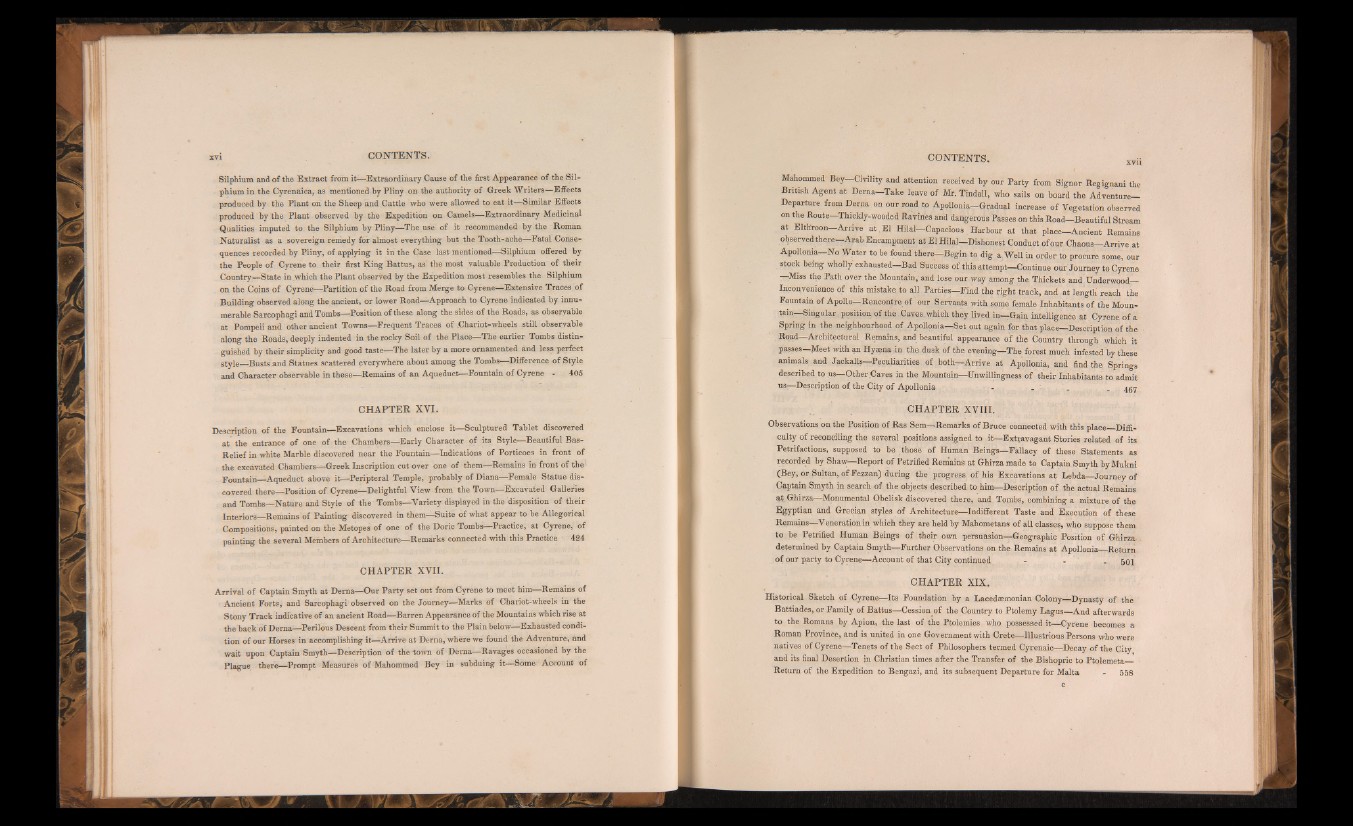
Silphium and of the Extract from it—Extraordinary Cause of the first Appearance of-the Sil-
phium in the Cyrenaica, as mentioned by Pliny on the authority of Greek W riters—Effects
produced by the Plant on the Sheep and Cattle who were allowed to eat it—Similar Effects
produced by the Plant observed by the Expedition on Camels—Extraordinary Medicinal
Qualities imputed to the Silphium by Pliny—The use of it recommended by the Roman
Naturalist as a sovereign remedy for almost everything but the Tooth-ache—Fatal Consequences
recorded by Pliny, of applying it in the Case last mentioned—Silphium offered by
the People of Cyrene to their first King Battus, as the most valuable Production of their
Country—State in which the Plant observed by the Expedition most resembles the Silphium
on the Coins of Cyrene—Partition of the Road from Merge to Cyrene—Extensive Traces of
Building observed along the ancient, or lower Road—Approach to Cyrene indicated by innumerable
Sarcophagi and Tombs—Position of these along the sides of the Roads, as observable
at Pompeii and other ancient Towns—Frequent Traces of .Chariot-wheels still observable
along the Roads, deeply indented in the rocky Soil of the Place—The earlier Tombs distinguished
by their simplicity and good taste—The later by a more ornamented and less perfect
style—Busts and Statues scattered everywhere about among the Tombs—Difference of Style
and Character observable in these—Remains of an Aqueduct—Fountain of Cyrene - 405
CH APTER XVI.
Description of the Fountain—Excavations which enclose it—Sculptured Tablet discovered
at the entrance of one of the Chambers—Early Character of its Style—Beautiful Bas-
Relief in white Marble discovered near the Fountain—Indications of Porticoes in front of
the excavated Chambers—-Greek Inscription cut over one of them—Remains in front of the
Fountain—Aqueduct above it—Peripteral Temple, probably of Diana—Female Statue discovered
there—Position of Cyrene—Delightful View from the Town—Excavated Galleries
and Tombs—Nature and Style of the Tombs—Variety displayed in the disposition of their
Interiors—Remains of Painting discovered in them—Suite of what appear to be Allegorical
Compositions, painted on the Metopes of one of the Doric Tombs—Practice, at Cyrene, of
painting the several Members of Architecture—Remarks connected with this Practice 424
CH APTER XVII.
Arrival of Captain Smyth at Derna—Our Party set out from Cyrene to meet him—Remains of
Ancient Forts, and Sarcophagi observed on the Journey—Marks of Chariot-wheels in the
Stony Track indicative of an ancient Road—Barren Appearance of the Mountains which rise at
the back of Dema—Perilous Descent from their Summit to the Plain below—Exhausted condition
of our Horses in accomplishing it—Arrive at Derna, where we found the Adventure, and
wait upon Captain Smyth—Description of the town of Derna—Ravages occasioned by the
Plague there—Prompt Measures of Mahommed Bey in subduing it—Some Account of
Mahommed Bey—Civility and attention received by our Party from Signor Regignani the
British Agent at Derna—Take leave of Mr. Tindall, who sails on board the Adventure__
Departure from Derna on our road tp Apollonia—Gradual increase of Vegetation observed
on the Route Thickly-wooded Ravines and dangerous Passes on this Road—Beautiful Stream
at Eltbroon = Arrive a t,E l Hilal—Capacious Harbour at that place—Ancient Remains
observed there—Arab Encampment at El Hilal—Dishonest Conduct of our Chaous—Arrive at
Apollonia—No Water to be fouhd there—Begin to dig a Well in order to procure some, our
stock being wholly exhausted—Bad Success of this attempt—Continue our'Journey to Cyrene
—Miss the Path over the Mountain, and lose our way among the Thickets and Underwood—
Inconvenience of this mistake to all Parties—Find the right track, and at length reach the
Fountain of Apollo—Rencontre of our Servants with some female Inhabitants of the Mountain
Singular j position of the Caves, which they lived in—Gain intelligence at Cyrene. of a
Spring in the. neighbourhood of Apollonia—Set out again for that place—Description of the
Road—Architectural Remains, and beautiful appearance of the Country through which it
passes—Meet with an Hyaena in the dusk of the evening—The forest much infested by these
animals and Jackalls—Peculiarities of both—Arrive at Apollonia, and find the Springs
described to us—Other Caves in the Mountain—Unwillingness of their Inhabitants to admit
us—Description of the City of Apollonia - . _ . 467
CHAPTER XVIII.
Observations on the Position of Ras Sem—Remarks of Bruce connected with this place Difficulty
of reconciling the several positions assigned to it—Extravagant Stories related of its
Petrifactions, supposed to be those of Hiiman Beings—Fallacy of these Statements as
recorded by Shaw—Report of Petrified Remains at Ghirza made to Captain Smyth by Mukni
(Bey, or Sultan, of Fezzan) during the progress of his Excavations at Lebda—Journey of
Captain Smyth in search of the objects described to him—Description of the actual Remains
at Ghirza—Monumental Obelisk discovered there, and Tombs, combining a mixture of the
Egyptian and Grecian styles of Architecture—Indifferent Taste and Execution of these
Remains—Veneration in which they are held by Mahometans of all classes, who suppose them
to ,be Petrified Human Beings of their own persuasion—Geographic Position of Ghirza .
determined by Captain Smyth—Further Observations on the Remains at Apollonia Return
of our party to Cyrene—Account of that City continued, - - - 501
CHAPTER XIX.
Historical Sketch of Cyrene—Its Foundation by a Lacedaemonian Colony—Dynasty of the
Battiades, or Family of Battus—Cessionof the Country to Ptolemy Lagus—And afterwards
to the Romans by Apion, the last of the Ptolemies who possessed it—Cyrene becomes a
Roman Province, and is united in one Government with Crete—Illustrious Persons who were
natives of Cyrene—Tenets of the Sect of Philosophers termed Cyrenaic—Decay of the City
and its final Desertion in Christian times after the Transfer of the Bishopric to Ptolemeta -
Return of the Expedition to Bengazi, and its subsequent Departure for Malta - 558